
Screenshot: Fallout 76 B.E.T.A.
In retrospect,
my initial impressions (or non-impressions) of the Fallout 76 B.E.T.A. may have been a little biased.
Fallout 76 didn’t really seem like something I wanted when it was initially announced. First of all, open world multiplayer survival games are usually about player versus player interactions, and rarely about exploring the worlds you inhabit. The lack of non-player characters also was a non-seller for me, since I thought that there would be little direction; instead you would have to find your own fun in a sandbox environment--again, not necessarily a bad thing, but not something that I associated with a
Fallout game. My fears weren’t totally unfounded, but honestly,
Fallout 76 feels closer to a
Fallout experience than I anticipated.

Screenshot: Fallout 76 B.E.T.A.
First off: yes, you’re forced to play with other players, and they can kill you—but surprisingly, this wasn’t an issue. Also, though there were a ton of bugs that we ran into through our B.E.T.A. playthrough, our enjoyment wasn’t really hampered by them—though I don’t anticipate
Fallout 76 being totally bug-free by the time it releases. I can’t say that I really ever wanted multiplayer in
Fallout, but now that I have it, it’s actually a lot of fun running around the wasteland with friends. My initial first impression of Fallout 76 has, surprisingly to me, been a good one.

Screenshot: Fallout 76 B.E.T.A.
If you’ve played
Fallout 4, you’ll feel right at home in
Fallout 76. The graphics are similar, but the movement and gunplay feels straight from its predecessor. Despite the lack of human non-player characters, there are actually quite a few non-player characters that you can interact with—though these are mostly merchants, or part of strange encounters across the wasteland. You won’t be completely directionless, either, as early on you are following the path of your vault’s overseer, and using her early departure as a guide for your trek across the wastes.
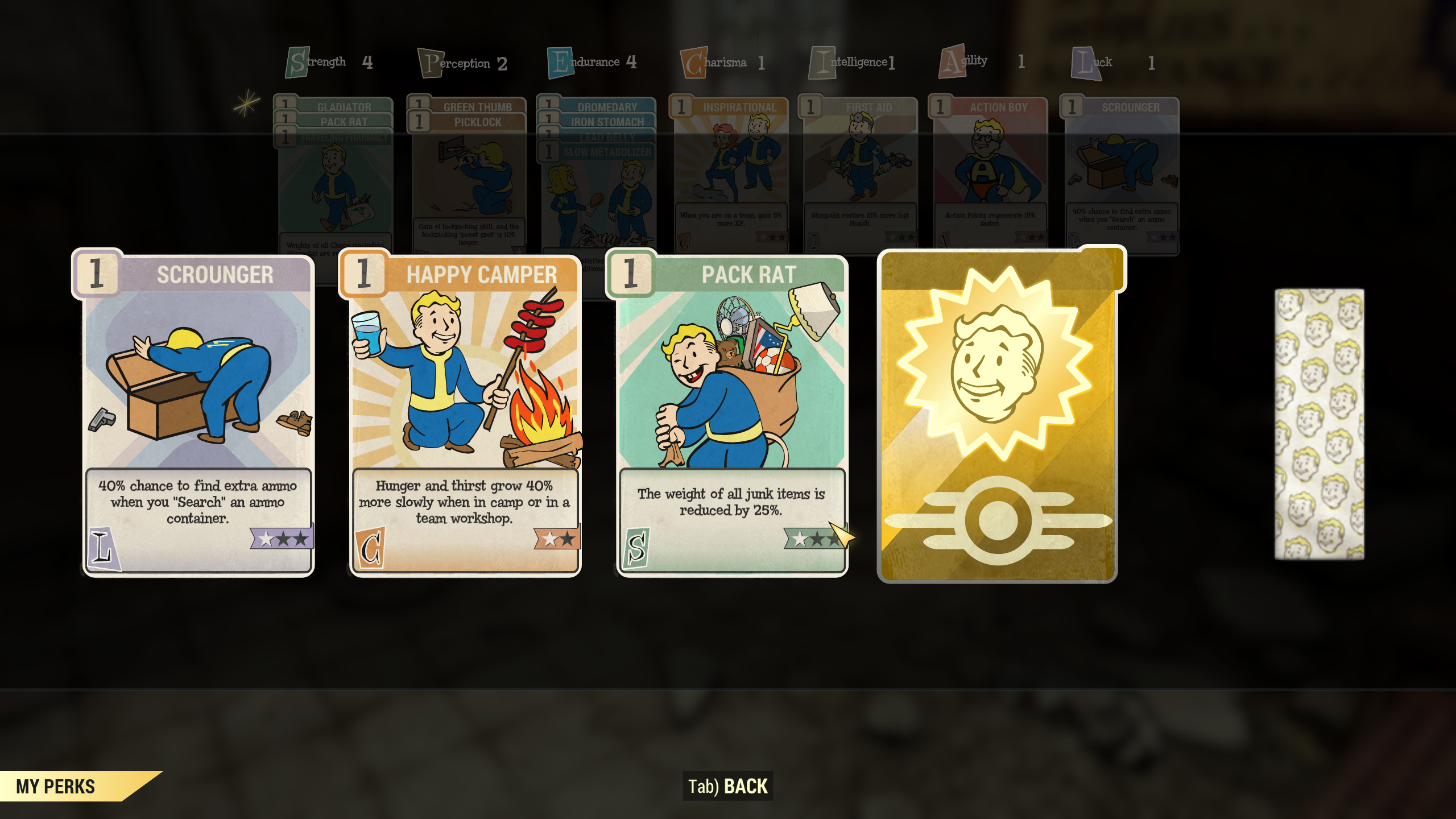
Screenshot: Fallout 76 B.E.T.A.
While
Fallout 76 is still a role-playing game, it approaches these elements a little differently than the other games in the series. Inventory management works similarly to that of
Fallout 4, as you use your Pip-Boy mainly to interact with your character and your characters' stuff. The perk/ability system is a little different, though. Instead of just choosing perks, you have several different perk cards to choose from. It appears as though people get these perk cards randomly, though, and you open up different sets with different abilities. People may not like the randomness of it, but I thought this system was interesting. After you collect multiples of the same perk card, you can combine them to make a higher level perk. The amount of cards you have assigned depends on how many points you have assigned to that attribute spread across the familiar S.P.E.C.I.A.L. system used from previous games in the series.

Screenshot: Fallout 76 B.E.T.A.
This is the earliest
Fallout in the series' chronology. You play as a dweller of Vault 76, completely making your own character with your own destiny in the wasteland, 25 years after the bombs dropped. This Appalachia wasteland is full of creatures never before seen in a
Fallout game, while containing many familiar mutated beasties and themes that have been explored before. Super Mutants return, as well as Feral Ghouls. But Feral Ghouls have new competition in the zombie-enemy department as a new breed of ghoul-like creature called The Scorched are unique to Appalachia, and spread through a plague that you are tasked to curing.
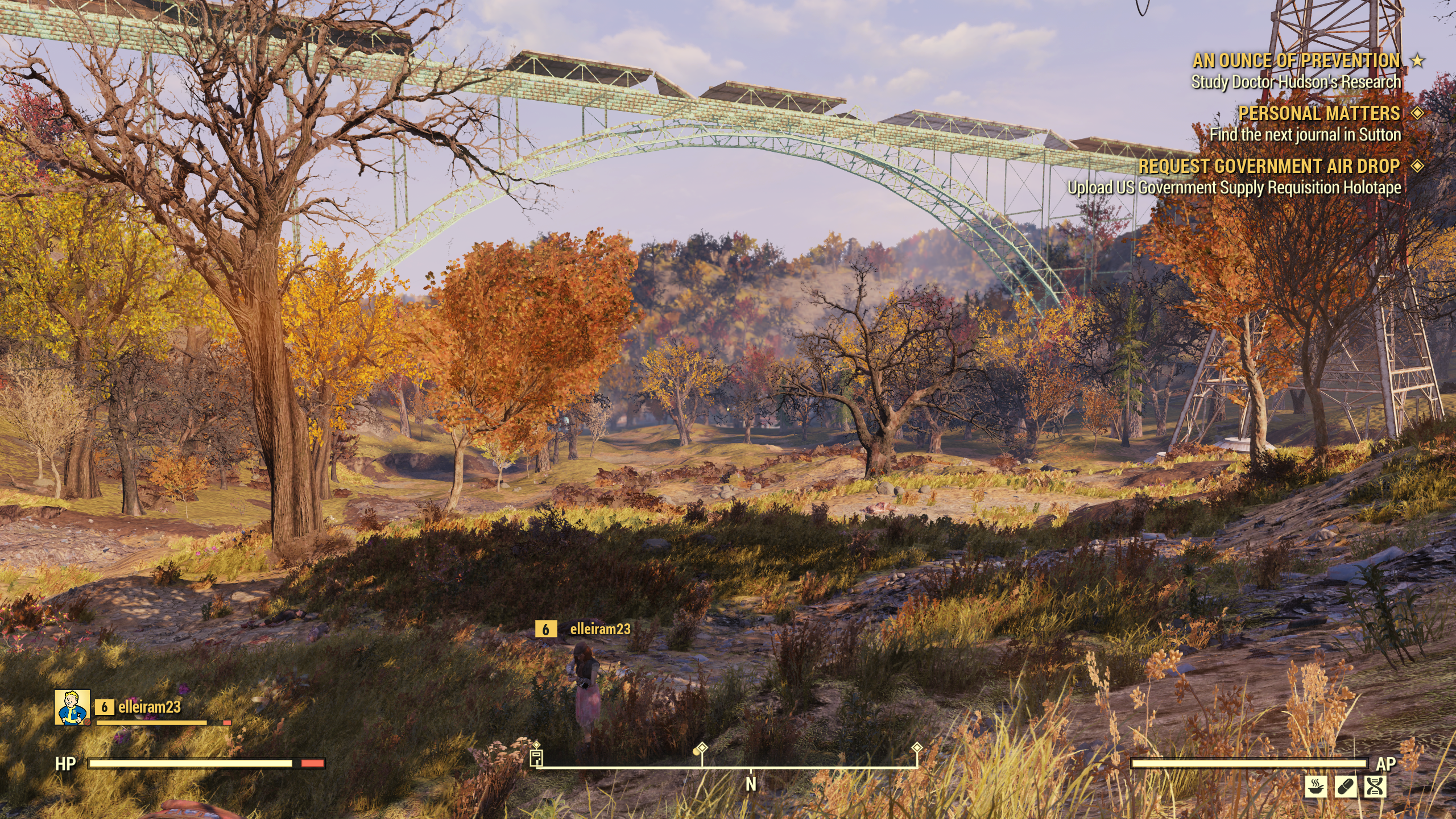
Screenshot: Fallout 76 B.E.T.A.
Appalachia is a colorful, interesting location. Not just a flat wasteland, Appalachia has lots of elevation changes, and a few different destroyed cities to scavenge your way through. Based on a location in West Virginia, this part of the country isn’t a glowing sea 25 years after the bombs, but instead a pretty verdant, lush, mostly beautiful land that is a joy to explore.

Screenshot: Fallout 76 B.E.T.A.
I spent very little time with building out a camp for myself, but it works similarly to
Fallout 4—except that you can set up your camp almost anywhere. In order to start a settlement, you have to deploy your C.A.M.P. device, which blocks off a relatively small area that you can then build in. I didn’t have much available to me to try out, as many blueprints are found or purchased as you make your way across Appalachia.

Screenshot: Fallout 76 B.E.T.A.
Crafting is a pretty big part of
Fallout 76. You can make weapons, armor—or modify any weapons or armor you already have/find. Just like in
Fallout 4, there are a lot of different ways you can modify weapons—if you have the right materials. Weapons also lose durability as you use them, so finding stuff to keep your weapons and armor maintained is actually a pretty big part of
Fallout 76. Don’t just pick up every bit of junk, either, as you’ll find yourself overencumbered easily. You can also craft all sorts of food, medicines, and drugs to help stimulate your character—try not to get addicted, though.
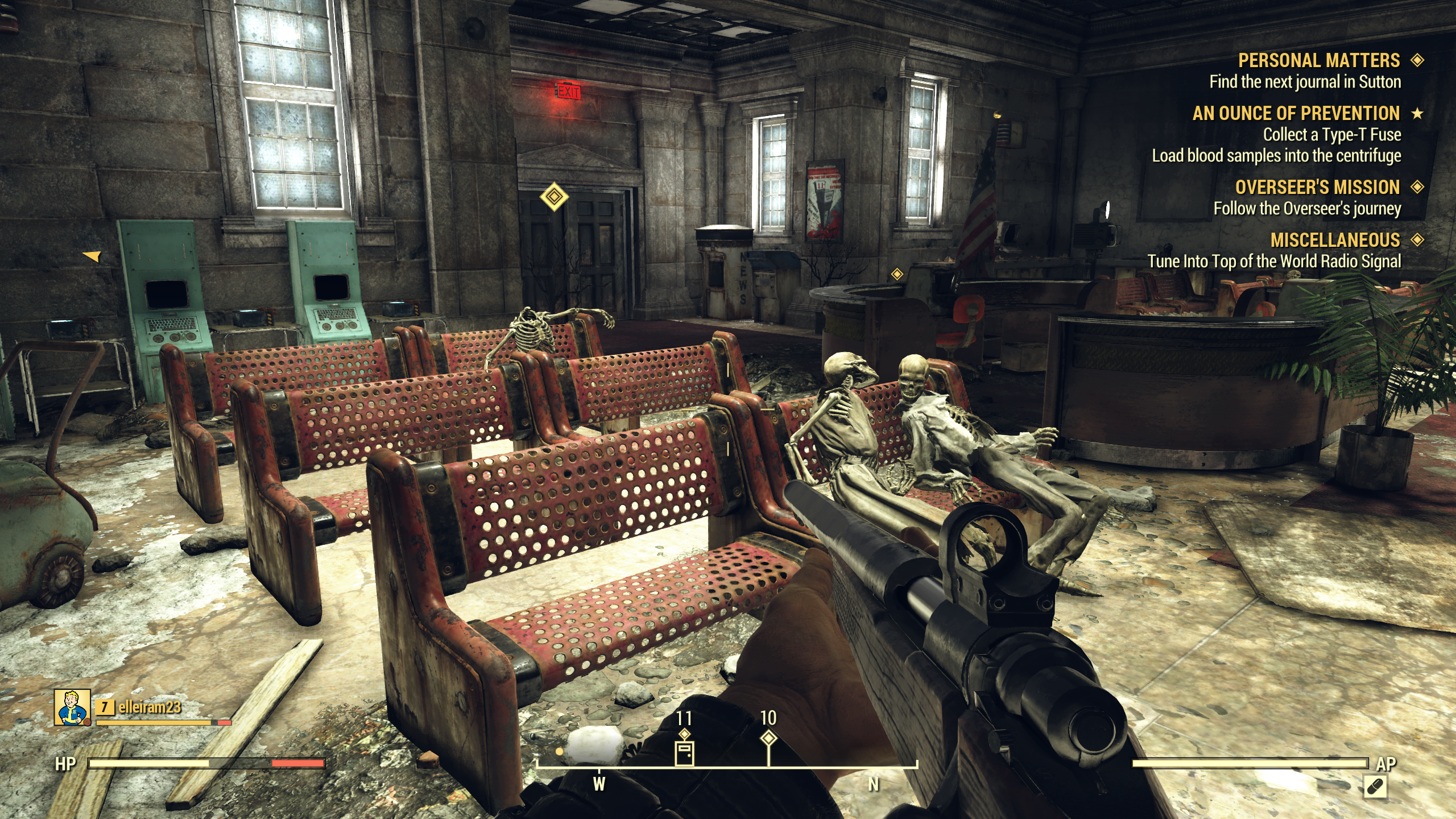
Screenshot: Fallout 76 B.E.T.A.
There are a few
Fallout mechanics that still surprisingly exist in
Fallout 76. Fast travel was something I was sure they would leave out, as well as sleeping—because you can’t accelerate time with other players still interacting with the world. Fast travelling exists though, and just like in previous
Fallout games can be done from anywhere outside. It now costs caps to travel, but you will arrive instantaneously to your destination (sans loading time.) Sleeping doesn’t accelerate time anymore, instead being a means to heal without healing items—but it just takes a while, and feels somewhat useless considering the time it takes.
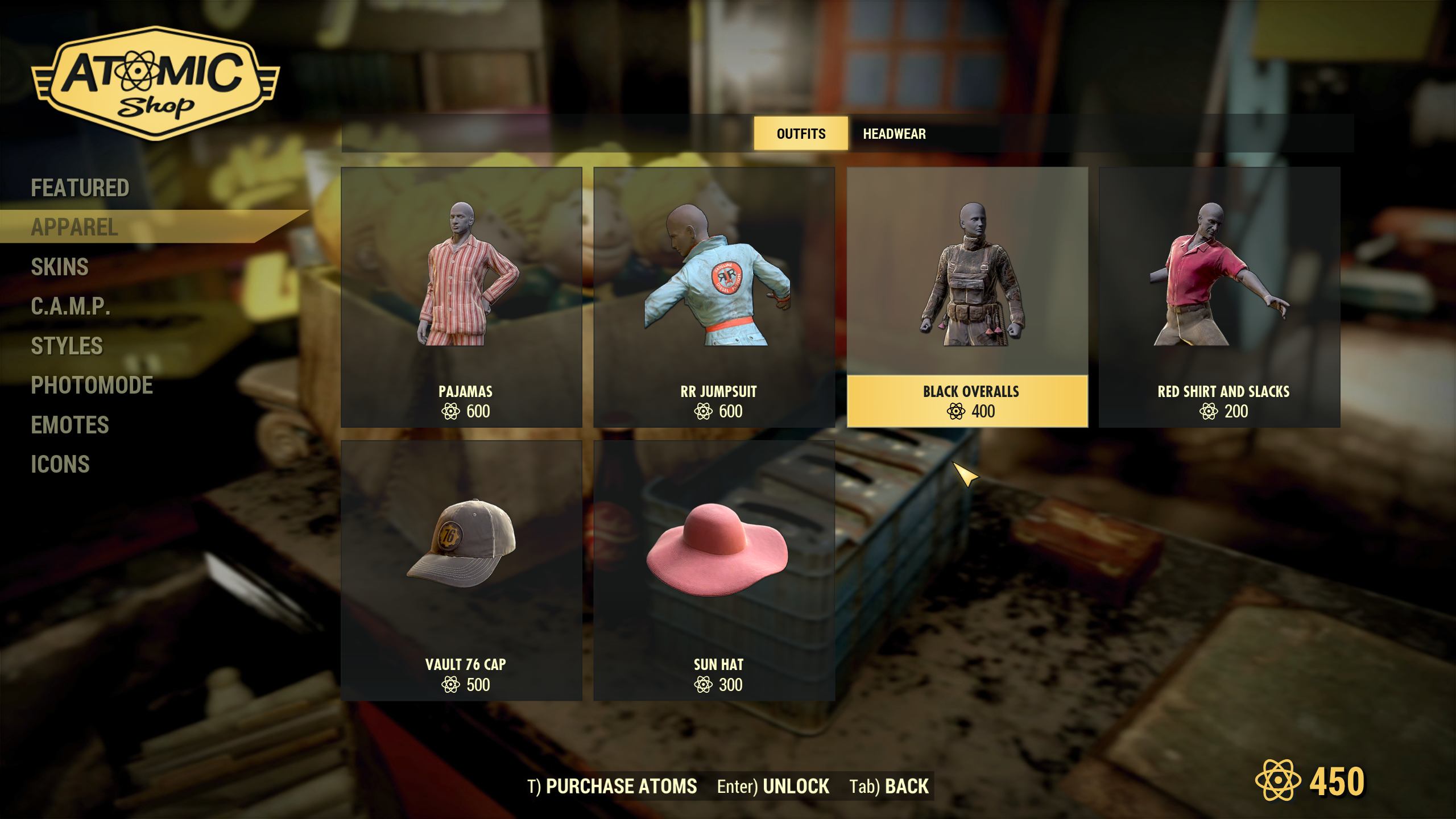
Screenshot: Fallout 76 B.E.T.A.
Completing challenges unlocks Atoms, which is the currency for microtransactions in
Fallout 76. At release you will be able to purchase these Atoms with real world money, but during the B.E.T.A. they did not have the cash packages available to test. The type of items you can purchase through Atoms are mostly cosmetic. There are some useful items—but nothing that alters gameplay to give you an advantage. The burning question I have about the challenges is: once you run out, are you forced to pay for Atoms, or will there be new challenges so you can keep earning that currency? Time will tell.

Screenshot: Fallout 76 B.E.T.A.
My biggest concern with
Fallout 76 is its longevity. I think I saw perhaps 30 percent of Appalachia, but I have no reference to how much more there might be, or what activities are still out there for me to discover. In
Fallout fashion there are tons of things off the main path to discover, but beyond base building and other such activities, I don’t know what kind of “end game” content is planned—something to work towards even after you’ve “seen everything.”
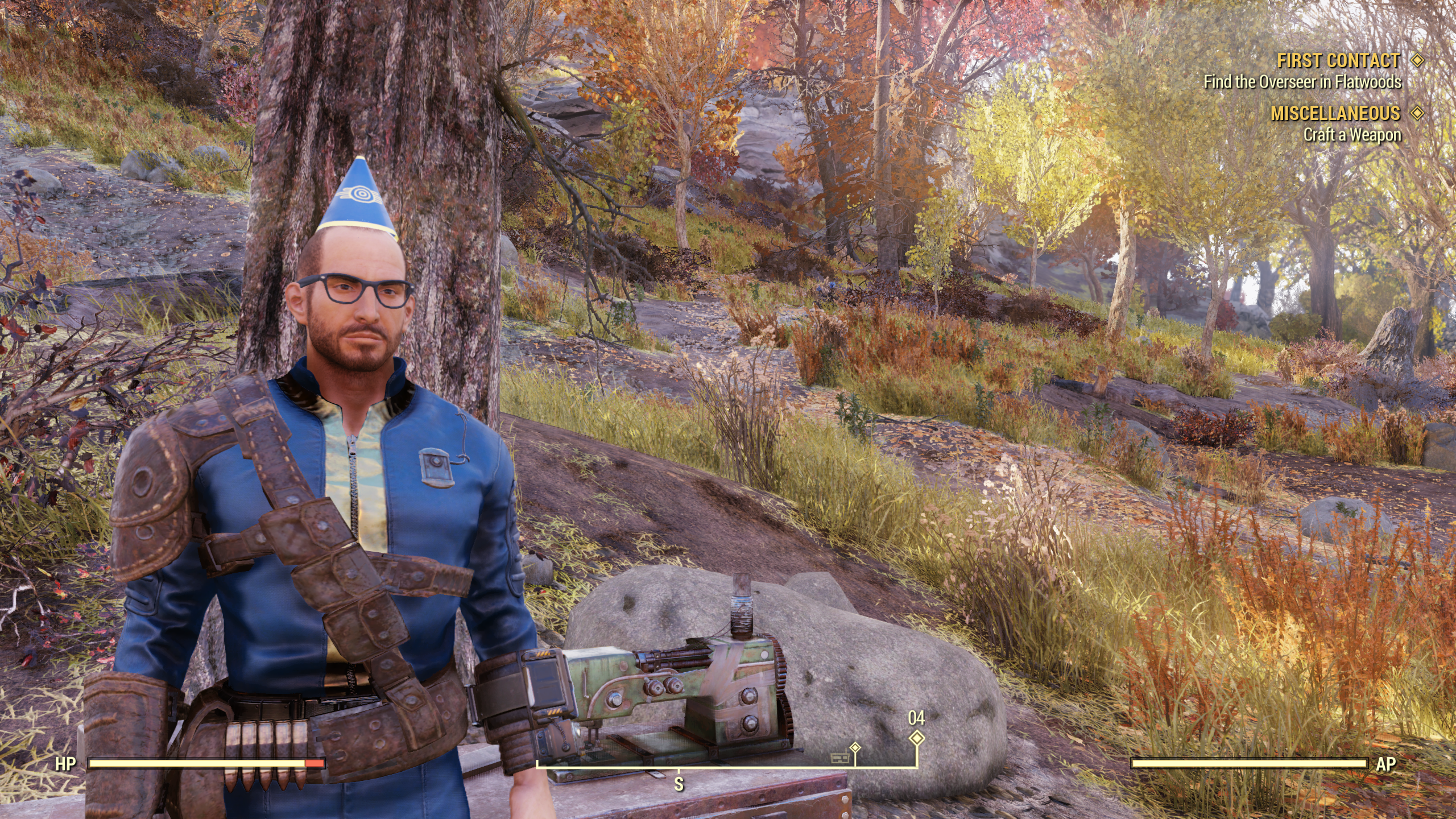
Screenshot: Fallout 76 B.E.T.A.
Fallout 76 is, so far, way more fun than I anticipated. When I first heard about it, I thought that a survival multiplayer game would not do the world justice, but I think I might be wrong. During my time with the B.E.T.A., players were not aggressive often against other players, and the interactions felt more like those you would have in a massively multiplayer online game instead of a kill-or-be-killed survival game. I worry about
Fallout 76's longevity, but this is a game I crave now that I don't have access to it. Once I turned on my Pip-Boy radio and those familiar songs came blaring out and I was looting my way through a ghoul infestation I just cleared out, I realized something important: this is still
Fallout, and this is fun.

Screenshot: Fallout 76 B.E.T.A.
If you missed the first set of scheduled B.E.T.A. times and wanted to give
Fallout 76 a try, don't despair. A new set of times was announced today, with a two hour slot scheduled on November 6 from 1 to 3pm ET and a second, longer slot on November 8 from 2 to 8pm ET.
Fallout 76 will be available on Windows, PlayStation 4, and Xbox One on November 14
th.
 Screenshot: Fallout 76 B.E.T.A.
In retrospect, my initial impressions (or non-impressions) of the Fallout 76 B.E.T.A. may have been a little biased. Fallout 76 didn’t really seem like something I wanted when it was initially announced. First of all, open world multiplayer survival games are usually about player versus player interactions, and rarely about exploring the worlds you inhabit. The lack of non-player characters also was a non-seller for me, since I thought that there would be little direction; instead you would have to find your own fun in a sandbox environment--again, not necessarily a bad thing, but not something that I associated with a Fallout game. My fears weren’t totally unfounded, but honestly, Fallout 76 feels closer to a Fallout experience than I anticipated.
Screenshot: Fallout 76 B.E.T.A.
In retrospect, my initial impressions (or non-impressions) of the Fallout 76 B.E.T.A. may have been a little biased. Fallout 76 didn’t really seem like something I wanted when it was initially announced. First of all, open world multiplayer survival games are usually about player versus player interactions, and rarely about exploring the worlds you inhabit. The lack of non-player characters also was a non-seller for me, since I thought that there would be little direction; instead you would have to find your own fun in a sandbox environment--again, not necessarily a bad thing, but not something that I associated with a Fallout game. My fears weren’t totally unfounded, but honestly, Fallout 76 feels closer to a Fallout experience than I anticipated.
 Screenshot: Fallout 76 B.E.T.A.
First off: yes, you’re forced to play with other players, and they can kill you—but surprisingly, this wasn’t an issue. Also, though there were a ton of bugs that we ran into through our B.E.T.A. playthrough, our enjoyment wasn’t really hampered by them—though I don’t anticipate Fallout 76 being totally bug-free by the time it releases. I can’t say that I really ever wanted multiplayer in Fallout, but now that I have it, it’s actually a lot of fun running around the wasteland with friends. My initial first impression of Fallout 76 has, surprisingly to me, been a good one.
Screenshot: Fallout 76 B.E.T.A.
First off: yes, you’re forced to play with other players, and they can kill you—but surprisingly, this wasn’t an issue. Also, though there were a ton of bugs that we ran into through our B.E.T.A. playthrough, our enjoyment wasn’t really hampered by them—though I don’t anticipate Fallout 76 being totally bug-free by the time it releases. I can’t say that I really ever wanted multiplayer in Fallout, but now that I have it, it’s actually a lot of fun running around the wasteland with friends. My initial first impression of Fallout 76 has, surprisingly to me, been a good one.
 Screenshot: Fallout 76 B.E.T.A.
If you’ve played Fallout 4, you’ll feel right at home in Fallout 76. The graphics are similar, but the movement and gunplay feels straight from its predecessor. Despite the lack of human non-player characters, there are actually quite a few non-player characters that you can interact with—though these are mostly merchants, or part of strange encounters across the wasteland. You won’t be completely directionless, either, as early on you are following the path of your vault’s overseer, and using her early departure as a guide for your trek across the wastes.
Screenshot: Fallout 76 B.E.T.A.
If you’ve played Fallout 4, you’ll feel right at home in Fallout 76. The graphics are similar, but the movement and gunplay feels straight from its predecessor. Despite the lack of human non-player characters, there are actually quite a few non-player characters that you can interact with—though these are mostly merchants, or part of strange encounters across the wasteland. You won’t be completely directionless, either, as early on you are following the path of your vault’s overseer, and using her early departure as a guide for your trek across the wastes.
 Screenshot: Fallout 76 B.E.T.A.
While Fallout 76 is still a role-playing game, it approaches these elements a little differently than the other games in the series. Inventory management works similarly to that of Fallout 4, as you use your Pip-Boy mainly to interact with your character and your characters' stuff. The perk/ability system is a little different, though. Instead of just choosing perks, you have several different perk cards to choose from. It appears as though people get these perk cards randomly, though, and you open up different sets with different abilities. People may not like the randomness of it, but I thought this system was interesting. After you collect multiples of the same perk card, you can combine them to make a higher level perk. The amount of cards you have assigned depends on how many points you have assigned to that attribute spread across the familiar S.P.E.C.I.A.L. system used from previous games in the series.
Screenshot: Fallout 76 B.E.T.A.
While Fallout 76 is still a role-playing game, it approaches these elements a little differently than the other games in the series. Inventory management works similarly to that of Fallout 4, as you use your Pip-Boy mainly to interact with your character and your characters' stuff. The perk/ability system is a little different, though. Instead of just choosing perks, you have several different perk cards to choose from. It appears as though people get these perk cards randomly, though, and you open up different sets with different abilities. People may not like the randomness of it, but I thought this system was interesting. After you collect multiples of the same perk card, you can combine them to make a higher level perk. The amount of cards you have assigned depends on how many points you have assigned to that attribute spread across the familiar S.P.E.C.I.A.L. system used from previous games in the series.
 Screenshot: Fallout 76 B.E.T.A.
This is the earliest Fallout in the series' chronology. You play as a dweller of Vault 76, completely making your own character with your own destiny in the wasteland, 25 years after the bombs dropped. This Appalachia wasteland is full of creatures never before seen in a Fallout game, while containing many familiar mutated beasties and themes that have been explored before. Super Mutants return, as well as Feral Ghouls. But Feral Ghouls have new competition in the zombie-enemy department as a new breed of ghoul-like creature called The Scorched are unique to Appalachia, and spread through a plague that you are tasked to curing.
Screenshot: Fallout 76 B.E.T.A.
This is the earliest Fallout in the series' chronology. You play as a dweller of Vault 76, completely making your own character with your own destiny in the wasteland, 25 years after the bombs dropped. This Appalachia wasteland is full of creatures never before seen in a Fallout game, while containing many familiar mutated beasties and themes that have been explored before. Super Mutants return, as well as Feral Ghouls. But Feral Ghouls have new competition in the zombie-enemy department as a new breed of ghoul-like creature called The Scorched are unique to Appalachia, and spread through a plague that you are tasked to curing.
 Screenshot: Fallout 76 B.E.T.A.
Appalachia is a colorful, interesting location. Not just a flat wasteland, Appalachia has lots of elevation changes, and a few different destroyed cities to scavenge your way through. Based on a location in West Virginia, this part of the country isn’t a glowing sea 25 years after the bombs, but instead a pretty verdant, lush, mostly beautiful land that is a joy to explore.
Screenshot: Fallout 76 B.E.T.A.
Appalachia is a colorful, interesting location. Not just a flat wasteland, Appalachia has lots of elevation changes, and a few different destroyed cities to scavenge your way through. Based on a location in West Virginia, this part of the country isn’t a glowing sea 25 years after the bombs, but instead a pretty verdant, lush, mostly beautiful land that is a joy to explore.
 Screenshot: Fallout 76 B.E.T.A.
I spent very little time with building out a camp for myself, but it works similarly to Fallout 4—except that you can set up your camp almost anywhere. In order to start a settlement, you have to deploy your C.A.M.P. device, which blocks off a relatively small area that you can then build in. I didn’t have much available to me to try out, as many blueprints are found or purchased as you make your way across Appalachia.
Screenshot: Fallout 76 B.E.T.A.
I spent very little time with building out a camp for myself, but it works similarly to Fallout 4—except that you can set up your camp almost anywhere. In order to start a settlement, you have to deploy your C.A.M.P. device, which blocks off a relatively small area that you can then build in. I didn’t have much available to me to try out, as many blueprints are found or purchased as you make your way across Appalachia.
 Screenshot: Fallout 76 B.E.T.A.
Crafting is a pretty big part of Fallout 76. You can make weapons, armor—or modify any weapons or armor you already have/find. Just like in Fallout 4, there are a lot of different ways you can modify weapons—if you have the right materials. Weapons also lose durability as you use them, so finding stuff to keep your weapons and armor maintained is actually a pretty big part of Fallout 76. Don’t just pick up every bit of junk, either, as you’ll find yourself overencumbered easily. You can also craft all sorts of food, medicines, and drugs to help stimulate your character—try not to get addicted, though.
Screenshot: Fallout 76 B.E.T.A.
Crafting is a pretty big part of Fallout 76. You can make weapons, armor—or modify any weapons or armor you already have/find. Just like in Fallout 4, there are a lot of different ways you can modify weapons—if you have the right materials. Weapons also lose durability as you use them, so finding stuff to keep your weapons and armor maintained is actually a pretty big part of Fallout 76. Don’t just pick up every bit of junk, either, as you’ll find yourself overencumbered easily. You can also craft all sorts of food, medicines, and drugs to help stimulate your character—try not to get addicted, though.
 Screenshot: Fallout 76 B.E.T.A.
There are a few Fallout mechanics that still surprisingly exist in Fallout 76. Fast travel was something I was sure they would leave out, as well as sleeping—because you can’t accelerate time with other players still interacting with the world. Fast travelling exists though, and just like in previous Fallout games can be done from anywhere outside. It now costs caps to travel, but you will arrive instantaneously to your destination (sans loading time.) Sleeping doesn’t accelerate time anymore, instead being a means to heal without healing items—but it just takes a while, and feels somewhat useless considering the time it takes.
Screenshot: Fallout 76 B.E.T.A.
There are a few Fallout mechanics that still surprisingly exist in Fallout 76. Fast travel was something I was sure they would leave out, as well as sleeping—because you can’t accelerate time with other players still interacting with the world. Fast travelling exists though, and just like in previous Fallout games can be done from anywhere outside. It now costs caps to travel, but you will arrive instantaneously to your destination (sans loading time.) Sleeping doesn’t accelerate time anymore, instead being a means to heal without healing items—but it just takes a while, and feels somewhat useless considering the time it takes.
 Screenshot: Fallout 76 B.E.T.A.
Completing challenges unlocks Atoms, which is the currency for microtransactions in Fallout 76. At release you will be able to purchase these Atoms with real world money, but during the B.E.T.A. they did not have the cash packages available to test. The type of items you can purchase through Atoms are mostly cosmetic. There are some useful items—but nothing that alters gameplay to give you an advantage. The burning question I have about the challenges is: once you run out, are you forced to pay for Atoms, or will there be new challenges so you can keep earning that currency? Time will tell.
Screenshot: Fallout 76 B.E.T.A.
Completing challenges unlocks Atoms, which is the currency for microtransactions in Fallout 76. At release you will be able to purchase these Atoms with real world money, but during the B.E.T.A. they did not have the cash packages available to test. The type of items you can purchase through Atoms are mostly cosmetic. There are some useful items—but nothing that alters gameplay to give you an advantage. The burning question I have about the challenges is: once you run out, are you forced to pay for Atoms, or will there be new challenges so you can keep earning that currency? Time will tell.
 Screenshot: Fallout 76 B.E.T.A.
My biggest concern with Fallout 76 is its longevity. I think I saw perhaps 30 percent of Appalachia, but I have no reference to how much more there might be, or what activities are still out there for me to discover. In Fallout fashion there are tons of things off the main path to discover, but beyond base building and other such activities, I don’t know what kind of “end game” content is planned—something to work towards even after you’ve “seen everything.”
Screenshot: Fallout 76 B.E.T.A.
My biggest concern with Fallout 76 is its longevity. I think I saw perhaps 30 percent of Appalachia, but I have no reference to how much more there might be, or what activities are still out there for me to discover. In Fallout fashion there are tons of things off the main path to discover, but beyond base building and other such activities, I don’t know what kind of “end game” content is planned—something to work towards even after you’ve “seen everything.”
 Screenshot: Fallout 76 B.E.T.A.
Fallout 76 is, so far, way more fun than I anticipated. When I first heard about it, I thought that a survival multiplayer game would not do the world justice, but I think I might be wrong. During my time with the B.E.T.A., players were not aggressive often against other players, and the interactions felt more like those you would have in a massively multiplayer online game instead of a kill-or-be-killed survival game. I worry about Fallout 76's longevity, but this is a game I crave now that I don't have access to it. Once I turned on my Pip-Boy radio and those familiar songs came blaring out and I was looting my way through a ghoul infestation I just cleared out, I realized something important: this is still Fallout, and this is fun.
Screenshot: Fallout 76 B.E.T.A.
Fallout 76 is, so far, way more fun than I anticipated. When I first heard about it, I thought that a survival multiplayer game would not do the world justice, but I think I might be wrong. During my time with the B.E.T.A., players were not aggressive often against other players, and the interactions felt more like those you would have in a massively multiplayer online game instead of a kill-or-be-killed survival game. I worry about Fallout 76's longevity, but this is a game I crave now that I don't have access to it. Once I turned on my Pip-Boy radio and those familiar songs came blaring out and I was looting my way through a ghoul infestation I just cleared out, I realized something important: this is still Fallout, and this is fun.
 Screenshot: Fallout 76 B.E.T.A.
If you missed the first set of scheduled B.E.T.A. times and wanted to give Fallout 76 a try, don't despair. A new set of times was announced today, with a two hour slot scheduled on November 6 from 1 to 3pm ET and a second, longer slot on November 8 from 2 to 8pm ET.
Fallout 76 will be available on Windows, PlayStation 4, and Xbox One on November 14th.
Screenshot: Fallout 76 B.E.T.A.
If you missed the first set of scheduled B.E.T.A. times and wanted to give Fallout 76 a try, don't despair. A new set of times was announced today, with a two hour slot scheduled on November 6 from 1 to 3pm ET and a second, longer slot on November 8 from 2 to 8pm ET.
Fallout 76 will be available on Windows, PlayStation 4, and Xbox One on November 14th.